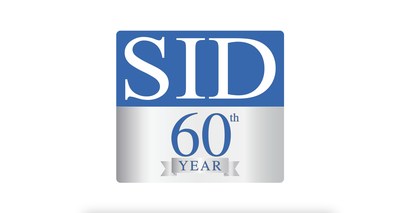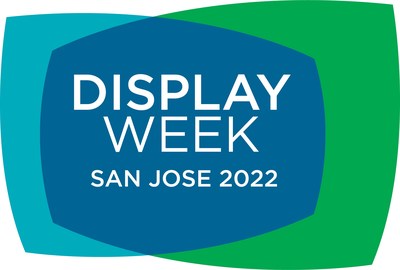
Society for Information Display Unveils 2022 Display Industry Award Winners
Recipients of 28th Annual Awards recognized for the year’s most significant technological advances
CAMPBELL, Calif., May 3, 2022 /PRNewswire/ — The Society for Information Display (SID) today announced the winners of its 28th Annual Display Industry Awards. The 2022 Display Industry Award (DIA) recipients reflect the ever-evolving display product landscape and represent a wide range of technological advancements with products designed to make devices that are more sustainable, economical, and engaging while providing users with a more dynamic visual experience. The honorees are receiving awards in conjunction with SID’s annual Display Week, held in San Jose, California, May 8-13, 2022. Display Week is the world’s leading event focused on emerging electronic display and visual information technologies from concept to market.
The 2022 Display Industry Award winners embody the profound level of innovation within the industry and exemplify how crucial displays have become to nearly every aspect of daily life.
“We continue to see a broad range of innovations coming from the display industry,” said Wei Chen, chair of the DIA Committee. “The miniLED backlight technology helps to push the performance of LCDs to a new level for electronic tablets, notebook computers, as well as LCD TVs. Foldable display technology continues its rapid pace of improvement.
“Breakthroughs in display components, such as high-acuity reflective polarizers and air-stable quantum dots, are expected to jump start the growth of high-performance VR displays and expand the usage of quantum dots in TVs, respectively,” he added. “This year’s awards also recognize the enhanced experiences electronic displays bring to cars and the innovative use of LED displays to enable a virtual production environment for movies and television.”
Among the industry’s highest honors, the Display Industry Awards highlight innovations that have advanced the state-of-the-art in display technology, with awards presented in three categories: Displays of the Year, Display Components of the Year, and Display Applications of the Year. The seven winners, divided into three categories, were chosen by a distinguished panel of experts who evaluated the nominees based on degree of technical innovation and commercial significance, as well as potential for positive social impact.
The award-winning products and innovations are listed below:
Displays of the Year
This award is granted to display products with the most significant technological advances or outstanding features.
Apple: Liquid Retina XDR Display in iPad Pro and MacBook Pro
The Apple Liquid Retina XDR Display on the 12.9-inch iPad Pro and 14-inch and 16-inch MacBook Pro features extreme dynamic range with 1,000-nit full-screen-sustaining capability and 1,600-nit peak high luminance, with a 1,000,000:1 contrast ratio. A DCI-P3 wide color gamut with 1 billion colors delivers rich and vibrant colors. ProMotion display technology, with variable refresh rates within 24–120 Hz, delivers a responsive viewing experience. Ultralow reflectivity helps users stay focused on the content, even in high ambient lighting conditions. Each display is carefully calibrated in the factory, and when combined with color management that’s built into iPadOS and macOS, the Liquid Retina XDR Display delivers an optimal viewing experience. The Apple Liquid Retina XDR Display performance is enabled by a new 2D mini-LED backlight, not only in the design, but also in the manufacturing. With its incredible color, brightness, and contrast performance enabled by design innovations, the Apple Liquid Retina XDR Display brings the extreme dynamic range experience to a whole new level.
Samsung Display: Foldable display with Eco2 OLED
Eco2 OLED is a technology that removes the polarizer, which is used to reduce the reflection of external light and integrates its functionality into the OLED panel layer. The Eco2 OLED display is eco-friendly by reducing the use of plastics. The new integrated polarizer brings foldable displays into the future and delivers the same luminance as conventional displays without stressing the battery. Also, Samsung’s Eco2 OLED delivers the best color performance of any smartphone display (DCI-P3, 125 percent; REC 2020, 91 percent). With improved transmittance, the integrated polarizer also achieves advanced color purity. As a first for smartphones, it has an ingress protection (IP) rating of IPX8 that safely keeps it protected from accidental spills. The IPX8 grade can withstand up to 30 minutes of fresh water at a depth of 1.5 m. In addition to 200,000 folding tests at conventional room temperature, it passed 30,000 tests at –20°C (–4°F) and was internationally certified by the Bureau Veritas. Samsung Display’s Eco2 OLED technology also is available for other applications, such as laptops.
Display Components of the Year
This award recognizes novel components that have significantly enhanced the performance of a display. A component is sold as a separate part destined to be incorporated into a display. A component may also include display-enhancing materials and/or parts fabricated with new processes.
3M: High-acuity reflective polarizer (HARP) lens
The 3M HARP lens integrates a birefringent reflective polarizer used to produce compact, mid-field-of-view (FoV) eyepieces and wide-FoV optics for virtual reality (VR) head-mounted displays using folded optics in the lens configuration. Multiple configurations for folded optic lens systems may be optimized, with varying performance relative to refractive systems. Polarization control is an important consideration, and different components cause different polarizing effects. Further, there are additional benefits of using folded optics in designs for mid- and wide-FoV in VR systems. Some devices both transmit and reflect light. One-way mirrors and mirrored sunglasses achieve this feat, but they use half-silvered mirrors to remove some light and transmit the rest. 3M uses reflective polarizers (based on its proprietary multilayer optical film technology) and quarter-wave plates to reflect or transmit light based on the polarization state: one polarity of light is reflected and the other is transmitted.
BOE Technology Group: 86-inch chip-on-glass active-matrix miniLED backlight unit
The active-matrix (AM) driving glass substrate technology adopted by the chip-on-glass (COG) miniLED backlight unit from BOE is based on semiconductor technology and using a glass substrate through BOE’s lateral processing technology. Glass is more suitable for making LED backlight arrays with dense arrangement and heat concentration. The miniLED unit is directly bonded to the glass substrate to realize the high-speed transfer of the LED chips and can realize precise, independent dimming control of the backlight unit. Compared with the traditional edge LED backlight, there are five advantages of the COG AM miniLED backlight unit. The technology has an ultrahigh brightness of the backlight, the peak luminance of the LCD with a COG AM miniLED backlight unit can reach 1,500 nits, and users can view a clear picture even in a bright environment. With 2,000 to 5,000 zones, the light control is more accurate and exquisite, and the contrast ratio of the LCD can be significantly improved to 1,000,000:1.
Nanosys: xQDEF diffuser plate with air-stable quantum dots
The Nanosys xQDEF Diffuser Plate brings together the color and brightness performance of QDEF QD technology with the precise light diffusion necessary for perfect contrast levels in miniLED and full-array local-dimming LCDs. As a direct replacement for diffuser plate components in direct-lit LCDs, the xQDEF Diffuser Plate simplifies the display assembly process, allowing display makers to design and build the most cost-effective displays with the widest color gamut. Compared with other wide color gamut solutions, the xQDEF Diffuser Plate implementation results in close to no additional material costs. The xQDEF Diffuser Plate has been enthusiastically embraced by the display industry. By the end of 2021, more than a million TVs with xQDEF Diffuser Plates inside shipped into the market, and the future for air-stable QDs is bright.
Display Applications of the Year
This award acknowledges novel and outstanding applications of a display, where the display itself is not necessarily a new device.
Mercedes-Benz: Mercedes-Benz User Experience (MBUX) Hyperscreen
The curved large MBUX Hyperscreen is the first automotive series pillar-to-pillar unit and is the highlight in the new electric architecture Gen.2 interior program. A smart combination and integration of three innovative displays behind one curved cover glass merge almost seamlessly to create a customer experience of more than 141 centimeters appearing as one visual unit. The MBUX Hyperscreen contains a 12.3-inch (2,400 × RGBW × 900) LCD with direct-matrix backlight as instrument cluster display, a 17.7-inch (3,088 × RGB × 1,728) corner-cut plastic OLED as a central information display, a 12.3-inch (2,400 × RGB × 900) plastic OLED as a front passenger display, and a driver-monitoring infrared stereo camera and illumination with face and eye tracking technology located in the LCD notch area, required for advanced driver-assistance features.
Sony PCL, Sony Co., and Sony Innovation Studios: Crystal LED virtual production system solution
Sony has developed an LED Virtual Production (VP) system that enables a novel approach to film production. It works by displaying volumetrically captured images on its new direct-view “Crystal LED” B-series display as a background image, allowing for shooting of that background image with live subjects with its digital cinema camera, “VENICE.” The combined volumetric image then is edited and rendered through “Atom View,” a point-cloud rendering, editing, and coloring software solution from Sony Innovation Studios. Image perspective can be synchronized with camera motion, and the process, when viewed as a new production system, provides a new and efficient workflow for film and other content production. The VP system allows filmmakers more creative freedom with accurate color reproduction without color-shifting, and fewer artifact image problems such as moiré pattern and scan lines. These characteristics enable a photorealistic background image and freedom of camera motion.
A more comprehensive description of the award winners is included in the Display Week 2022 Show Issue of Information Display magazine or at www.informationdisplay.org. Also see www.sid.org. To be considered for a 2022 Display Industry Award, a product had to be available for purchase during the 2021 calendar year.
High resolution images are available upon request.
For more information about Display Week 2022, please visit www.displayweek.org.
About Display Week 2022
The 59th International Display Week Symposium and Seminar, presented by the Society for Information Display (SID), will be held in San Jose, California, May 8-13, 2022. Display Week is the world’s leading event focused on emerging electronic display and visual information technologies from concept to market. Display Week attracts attendees from the entire ecosystem of R&D, engineering, design, manufacturing, supply chain, marketing, sales and financial, as well as commercial and consumer end-user markets. It delivers unparalleled learning opportunities, market-moving trends, sourcing, roadmaps-to-market, and connections for career and business growth. For more information on Display Week 2022, visit www.displayweek.org or follow us on LinkedIn, Facebook, Twitter @DisplayWeek (hashtag #DisplayWeek2022), or the Display Week YouTube Channel
About SID
The Society for Information Display (SID) will celebrate its 60th anniversary in 2022. SID is the only professional organization focused on the electronic display and visual information technology industries. In fact, by exclusively focusing on the advancement of electronic display and visual information technologies, SID provides a unique platform for industry collaboration, communication and training in all related technologies while showcasing the industry’s best new products. The organization’s members are professionals in the technical and business disciplines that relate to display research, design, manufacturing, applications, marketing and sales. To promote industry and academic technology development, while also educating consumers on the importance of displays, SID hosts more than 10 conferences a year, including Display Week, which brings industry and academia all under one roof to showcase technology that will shape the future. SID’s global headquarters are located at 1475 S. Bascom Ave., Ste. 114, Campbell, CA 95008. For more information, visit www.sid.org.
![]() View original content to download multimedia:https://www.prnewswire.com/news-releases/society-for-information-display-unveils-2022-display-industry-award-winners-301537587.html
View original content to download multimedia:https://www.prnewswire.com/news-releases/society-for-information-display-unveils-2022-display-industry-award-winners-301537587.html
SOURCE SID


